《计算机英语(第3版)》(刘艺 王春生)练习参考答案
- 格式:pdf
- 大小:563.83 KB
- 文档页数:39
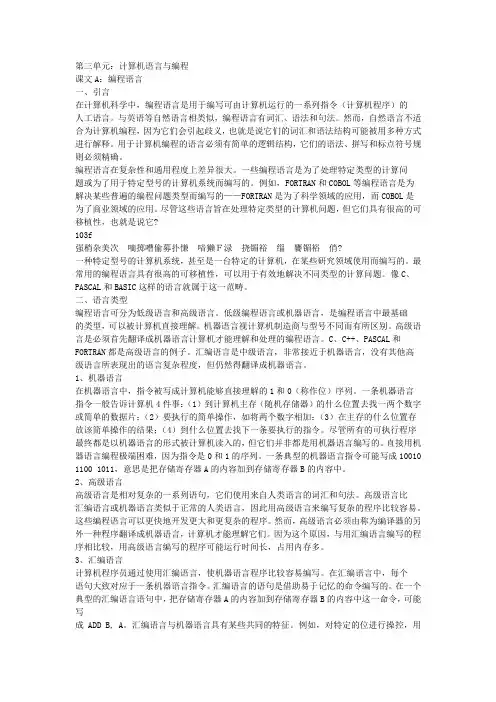
第三单元:计算机语言与编程课文A:编程语言一、引言在计算机科学中,编程语言是用于编写可由计算机运行的一系列指令(计算机程序)的人工语言。
与英语等自然语言相类似,编程语言有词汇、语法和句法。
然而,自然语言不适合为计算机编程,因为它们会引起歧义,也就是说它们的词汇和语法结构可能被用多种方式进行解释。
用于计算机编程的语言必须有简单的逻辑结构,它们的语法、拼写和标点符号规则必须精确。
编程语言在复杂性和通用程度上差异很大。
一些编程语言是为了处理特定类型的计算问题或为了用于特定型号的计算机系统而编写的。
例如,FORTRAN和COBOL等编程语言是为解决某些普遍的编程问题类型而编写的——FORTRAN是为了科学领域的应用,而COBOL是为了商业领域的应用。
尽管这些语言旨在处理特定类型的计算机问题,但它们具有很高的可移植性,也就是说它?103f强梢杂美次 嘀掷嘈偷募扑慊 喑獭F渌 挠镅裕 缁 饔镅裕 俏?一种特定型号的计算机系统,甚至是一台特定的计算机,在某些研究领域使用而编写的。
最常用的编程语言具有很高的可移植性,可以用于有效地解决不同类型的计算问题。
像C、PASCAL和BASIC这样的语言就属于这一范畴。
二、语言类型编程语言可分为低级语言和高级语言。
低级编程语言或机器语言,是编程语言中最基础的类型,可以被计算机直接理解。
机器语言视计算机制造商与型号不同而有所区别。
高级语言是必须首先翻译成机器语言计算机才能理解和处理的编程语言。
C、C++、PASCAL和FORTRAN都是高级语言的例子。
汇编语言是中级语言,非常接近于机器语言,没有其他高级语言所表现出的语言复杂程度,但仍然得翻译成机器语言。
1、机器语言在机器语言中,指令被写成计算机能够直接理解的1和0(称作位)序列。
一条机器语言指令一般告诉计算机4件事:(1)到计算机主存(随机存储器)的什么位置去找一两个数字或简单的数据片;(2)要执行的简单操作,如将两个数字相加;(3)在主存的什么位置存放该简单操作的结果;(4)到什么位置去找下一条要执行的指令。
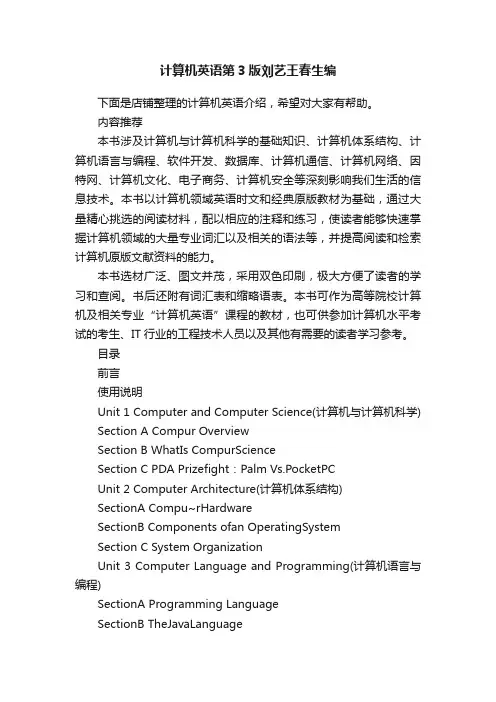
计算机英语第3版刘艺王春生编下面是店铺整理的计算机英语介绍,希望对大家有帮助。
内容推荐本书涉及计算机与计算机科学的基础知识、计算机体系结构、计算机语言与编程、软件开发、数据库、计算机通信、计算机网络、因特网、计算机文化、电子商务、计算机安全等深刻影响我们生活的信息技术。
本书以计算机领域英语时文和经典原版教材为基础,通过大量精心挑选的阅读材料,配以相应的注释和练习,使读者能够快速掌握计算机领域的大量专业词汇以及相关的语法等,并提高阅读和检索计算机原版文献资料的能力。
本书选材广泛、图文并茂,采用双色印刷,极大方便了读者的学习和查阅。
书后还附有词汇表和缩略语表。
本书可作为高等院校计算机及相关专业“计算机英语”课程的教材,也可供参加计算机水平考试的考生、IT行业的工程技术人员以及其他有需要的读者学习参考。
目录前言使用说明Unit 1 Computer and Computer Science(计算机与计算机科学) Section A Compur OverviewSection B WhatIs CompurScienceSection C PDA Prizefight:Palm Vs.PocketPCUnit 2 Computer Architecture(计算机体系结构)SectionA Compu~rHardwareSectionB Components ofan OperatingSystemSection C System OrganizationUnit 3 Computer Language and Programming(计算机语言与编程)SectionA Programming LanguageSectionB TheJavaLanguageSection C ArraysUnit 4 Software Development(软件开发) Section A Compu~r ProgramSectionB VS.J2EESection C Distributed SyswmsUnit 5 Software Process(软件过程)Section A Software Process ModelsSection B Model Driven DevelopmentSection C WhatIsaDesignPatternUnit 6 Database(数据库)Sectwn A Database 0verviewSection B Maintaining Database Integrity Section C .NET Data Access ArchitectureUnit 7 Computer Communications(计算机通信) Section A Telecommunications and Computer Section B Communicating with Other Devices Section C ATMandItsAdvantagesUnit 8 Computer Network(计算机网络)Sectwn A Network FundamentalsSection B A Guide to Network Topology Section C Network Connecting DevicesUnit 9 The Internet(因特网)SectionA TheInternetSectionB TheLayeredApproachtoInternetSoftware Section C WebBasicsUnit 10 Cyberculture(计算机文化)SectionA Using E-MailSection B Designing WebsitesSection C Web2.0andItsEconomicImplications Unit 11 Electronic Commerce(电子商务)Sectwn A Electronic CommerceSection B Basic Functions ofElectronic Commerce Software Section C OnlineShoppingUnit 12 Computer Security(计算机安全)Section A Computer SecuritySection B Antivirus SoftwareSection C ThroughaHacker'sEyesGlossary(词汇表)Abbreviations(缩略语表)。
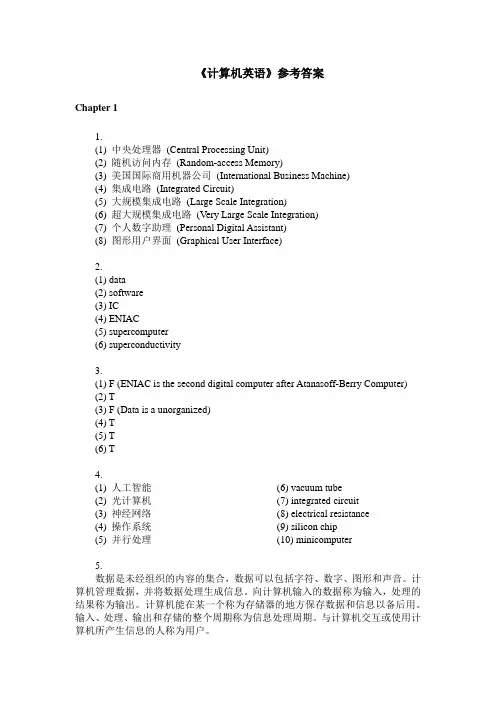
《计算机英语》参考答案Chapter 11.(1) 中央处理器(Central Processing Unit)(2) 随机访问内存(Random-access Memory)(3) 美国国际商用机器公司(International Business Machine)(4) 集成电路(Integrated Circuit)(5) 大规模集成电路(Large Scale Integration)(6) 超大规模集成电路(Very Large Scale Integration)(7) 个人数字助理(Personal Digital Assistant)(8) 图形用户界面(Graphical User Interface)2.(1) data(2) software(3) IC(4) ENIAC(5) supercomputer(6) superconductivity3.(1) F (ENIAC is the second digital computer after Atanasoff-Berry Computer)(2) T(3) F (Data is a unorganized)(4) T(5) T(6) T4.(1) 人工智能(2) 光计算机(3) 神经网络(4) 操作系统(5) 并行处理(6) vacuum tube(7) integrated circuit(8) electrical resistance(9) silicon chip(10) minicomputer5.数据是未经组织的内容的集合,数据可以包括字符、数字、图形和声音。
计算机管理数据,并将数据处理生成信息。
向计算机输入的数据称为输入,处理的结果称为输出。
计算机能在某一个称为存储器的地方保存数据和信息以备后用。
输入、处理、输出和存储的整个周期称为信息处理周期。
与计算机交互或使用计算机所产生信息的人称为用户。
1.(1) 发光二极管(Light-Emitting Diode)(2) 静态随机存储器(Static Random Access Memory)(3) 只读存储器(Read Only Memory)(4) 运算器(Arithmetic and Logical Unit)(5) 阴极射线管(Cathode Ray Tube)(6) 视频显示单元(Visual Display Unit)(7) 可编程只读存储器(Programmable Read Only Memory)(8) 液晶显示屏(Liquid Crystal Display)2.(1) CPU(2) peripheral(3) memory(4) modem(5) control unit(6) byte3.(1) T(2) T(3) F (RAM is volatile memory because the information within the computer chips is erased as soon as the computer is powered off whereas ROM is nonvolatile)(4) T(5) T(6) F (Microphones and digital cameras are input devices)4.(1) 寄存器组(2) 主机(3) 二进制的(4) 算法(5) 光盘(6) CD-RW(7) logic operation(8) barcode(9) peripheral device(10) volatile memory5.计算机的内存可被视为一系列的单元,可以在单元中存取数字。
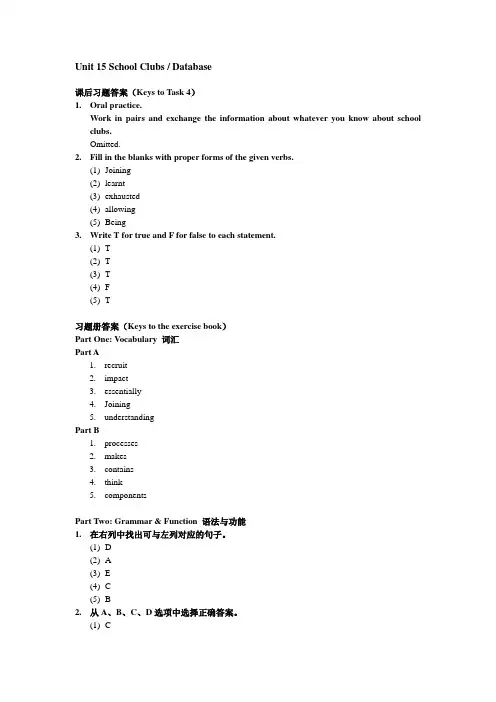
Unit 15 School Clubs / Database课后习题答案(Keys to Task 4)1.Oral practice.Work in pairs and exchange the information about whatever you know about school clubs.Omitted.2.Fill in the blanks with proper forms of the given verbs.(1)Joining(2)learnt(3)exhausted(4)allowing(5)Being3.Write T for true and F for false to each statement.(1)T(2)T(3)T(4) F(5)T习题册答案(Keys to the exercise book)Part One: Vocabulary 词汇Part A1.recruit2.impact3.essentially4.Joining5.understandingPart B1.processes2.makes3.contains4.thinkponentsPart Two: Grammar & Function 语法与功能1.在右列中找出可与左列对应的句子。
(1) D(2) A(3) E(4) C(5) B2.从A、B、C、D选项中选择正确答案。
(1) C(2) B(3) B(4) C(5) A(6) B(7) B(8) B(9) C(10) APart Three: Translation 翻译1.将下列短语翻译成英文。
(1)soft skills(2)positive ways(3)to take your advices(4)to store information(5)monetary values(6) a whole number2.将下列句子翻译成中文。
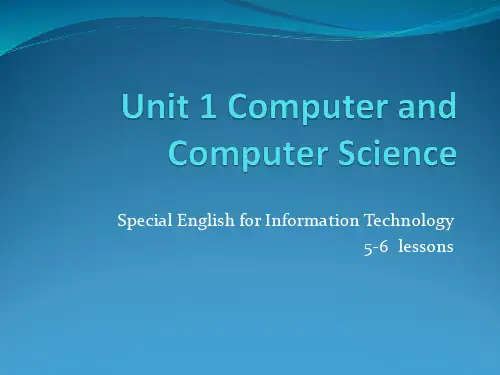
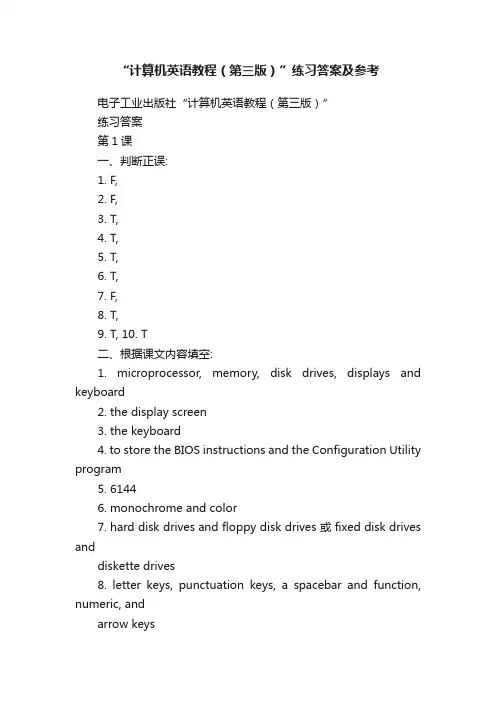
“计算机英语教程(第三版)”练习答案及参考电子工业出版社“计算机英语教程(第三版)”练习答案第1课一、判断正误:1. F,2. F,3. T,4. T,5. T,6. T,7. F,8. T,9. T, 10. T二、根据课文内容填空:1. microprocessor, memory, disk drives, displays and keyboard2. the display screen3. the keyboard4. to store the BIOS instructions and the Configuration Utility program5. 61446. monochrome and color7. hard disk drives and floppy disk drives 或 fixed disk drives anddiskette drives8. letter keys, punctuation keys, a spacebar and function, numeric, andarrow keys9. mouse10. baud rate三、指出下列句中的定语从句,然后把句子译成汉语。
1. where we put our computer我们放计算机的那个房间很大。
2. who are requiring the full color capabilities of the color VGA monitor那些要求彩色显示器具有全彩色性能的用户,将发现本彩色VGA 显示器是完美的选择。
3. why there are heat losses in a steam engine你知道为什么蒸气发动机中会有热量丢失吗?4. which allows electric current to flow easily能让电流容易流过的材料叫导体。
5. whose father works in AAA computer company汤姆就是那个他父亲在AAA计算机公司工作的学生。
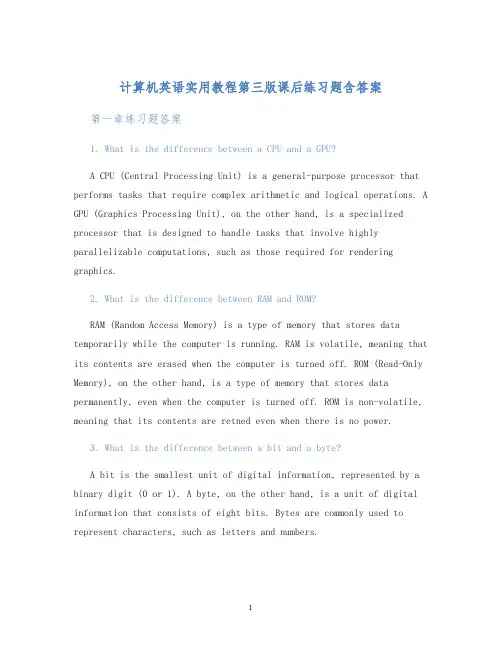
计算机英语实用教程第三版课后练习题含答案第一章练习题答案1. What is the difference between a CPU and a GPU?A CPU (Central Processing Unit) is a general-purpose processor that performs tasks that require complex arithmetic and logical operations. A GPU (Graphics Processing Unit), on the other hand, is a specialized processor that is designed to handle tasks that involve highly parallelizable computations, such as those required for rendering graphics.2. What is the difference between RAM and ROM?RAM (Random Access Memory) is a type of memory that stores data temporarily while the computer is running. RAM is volatile, meaning that its contents are erased when the computer is turned off. ROM (Read-Only Memory), on the other hand, is a type of memory that stores data permanently, even when the computer is turned off. ROM is non-volatile, meaning that its contents are retned even when there is no power.3. What is the difference between a bit and a byte?A bit is the smallest unit of digital information, represented by a binary digit (0 or 1). A byte, on the other hand, is a unit of digital information that consists of eight bits. Bytes are commonly used to represent characters, such as letters and numbers.4. What is the purpose of an operating system?An operating system (OS) is a software program that manages the resources of a computer, including the CPU, memory, storage, and devices such as printers and displays. The purpose of an operating system is to provide an environment in which applications can run and interact with the hardware without directly accessing the underlying hardware.5. What is the difference between a compiler and an interpreter?A compiler is a program that translates the source code of a program into executable code that can be run on a specific computer platform. The resulting executable code can be run multiple times without the need for recompilation. An interpreter, on the other hand, is a program that reads and executes source code instructions one at a time. Interpreted code is typically slower than compiled code, but does not require the extra step of compilation before it can be run.第二章练习题答案1. What is the difference between a LAN and a WAN?A LAN (Local Area Network) is a network that connects computers and other devices that are located in the same physical location, such as an office building or a home. A WAN (Wide Area Network), on the other hand, is a network that connects computers and other devices that are located in different physical locations, often separated by vast distances.2. What is a router and how does it work?A router is a device that connects two or more networks together and forwards data between them. Routers use routing tables to determine thebest path for data to take between networks, and use protocols such as TCP/IP to communicate with other devices on the network.3. What is the difference between TCP and UDP?TCP (Transmission Control Protocol) and UDP (User Datagram Protocol) are both protocols used for transmitting data over the internet. TCP is a connection-oriented protocol, which means that it establishes avirtual circuit between two endpoints over which data can be transmitted. TCP uses error correction and flow control to ensure that data arrivesat its destination correctly and in the correct order. UDP, on the other hand, is a connectionless protocol that does not establish a virtual circuit between endpoints. UDP does not provide error correction or flow control, but is often used in situations where speed and simplicity are more important than reliability.4. What is a DNS server?A DNS (Domn Name System) server is a special type of server that translates domn names into IP addresses. When a user enters a domn name into their web browser, the browser sends a request to a DNS server to find the corresponding IP address for that domn name. The DNS serverthen returns the IP address to the browser, which can then connect tothe website.5. What is a firewall and how does it work?A firewall is a security device that is used to protect a networkfrom unauthorized access. Firewalls can be implemented as hardware or software, and typically work by examining incoming and outgoing network traffic and blocking any traffic that does not meet a set of predefinedrules. Firewalls can be configured to block specific types of traffic, such as traffic from certn IP addresses or traffic that uses a certn protocol. Firewalls can also be configured to allow or deny access to specific network resources based on user or device credentials.。
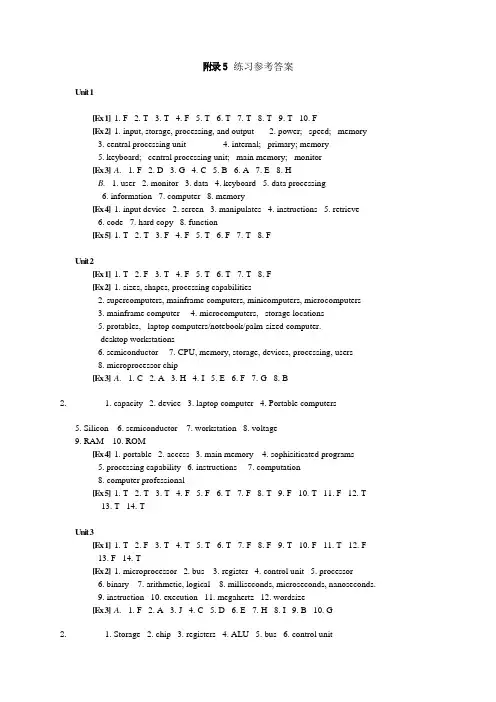
附录5练习参考答案Unit 1[Ex 1] 1. F 2. T 3. T 4. F 5. T 6. T 7. T 8. T 9. T 10. F[Ex 2] 1. input, storage, processing, and output 2. power; speed; memory3. central processing unit4. internal; primary; memory5. keyboard; central processing unit; main memory; monitor[Ex 3] A. 1. F 2. D 3. G 4. C 5. B 6. A 7. E 8. HB. 1. user 2. monitor 3. data 4. keyboard 5. data processing6. information7. computer8. memory[Ex 4] 1. input device 2. screen 3. manipulates 4. instructions 5. retrieve6. code7. hard copy8. function[Ex 5] 1. T 2. T 3. F 4. F 5. T 6. F 7. T 8. FUnit 2[Ex 1] 1. T 2. F 3. T 4. F 5. T 6. T 7. T 8. F[Ex 2] 1. sizes, shapes, processing capabilities2. supercomputers, mainframe computers, minicomputers, microcomputers3. mainframe computer4. microcomputers, storage locations5. protables, laptop computers/notebook/palm-sized computer.desktop workstations6. semiconductor7. CPU, memory, storage, devices, processing, users8. microprocessor chip[Ex 3] A. 1. C 2. A 3. H 4. I 5. E 6. F 7. G 8. B2. 1. capacity 2. device3. laptop computer4. Portable computers5. Silicon6. semiconductor7. workstation8. voltage9. RAM 10. ROM[Ex 4] 1. portable 2. access 3. main memory 4. sophisiticated programs5. processing capability6. instructions7. computation8. computer professional[Ex 5] 1. T 2. T 3. T 4. F 5. F 6. T 7. F 8. T 9. F 10. T 11. F 12. T13. T 14. TUnit 3[Ex 1] 1. T 2. F 3. T 4. T 5. T 6. T 7. F 8. F 9. T 10. F 11. T 12. F13. F 14. T[Ex 2] 1. microprocessor 2. bus 3. register 4. control unit 5. processor6. binary7. arithmetic, logical8. milliseconds, microseconds, nanoseconds.9. instruction 10. execution 11. megahertz 12. wordsize[Ex 3] A. 1. F 2. A 3. J 4. C 5. D 6. E 7. H 8. I 9. B 10. G2. 1. Storage 2. chip3. registers4. ALU5. bus6. control unit7. machine language 8. binary system 9. bits 10. computer program[Ex 4] 1. configuration 2. converts 3. data buses 4. characters5. decodes6. synchronize7. circuitry8. internal clock[Ex 5] 1. T 2. F 3. F 4. T 5. T 6. F 7. T 8. T 9. T 10 FUnit 4[Ex 1] 1. F 2. T 3. T 4. T 5. F 6. T 7. F 8. T 9. T 10. F 11. T 12. T13. F 14. F 15. T 16. F 17. T 18. F 19. T 20. F 21. T 22. F[Ex 2] 1. main memory 2. RAM 3. diskettes/floppy disks; hard disks4. chips5. parity6. expanded, extended7. monochrome8. cache 9. ROM 10. updated[Ex 3] A. 1. B 2. E 3. C 4. J 5. I 6. H 7. A 8. F 9. G 10 D2. 1. secondary srorage 2. buffer3. access4. code5. diskette6. slots7. terminals8. motherboard9. bytes 10. screen[Ex 4] 1. desktop 2. software 3. animation 4. transferred 5. sophisticated6. compatible7. cache8. upgrade[Ex 5] 1. T 2. F 3. T 4. T 5. F 6. T 7. F 8. T 9. T 10. T 11. T 12. T13. T 14. F 15. F 16. TUnit 5[Ex 1] 1. T 2. F 3. F 4. F 5. T 6. T 7. T 8. F 9. F 10. T 11. F 12. F13. T 14. T[Ex 2] 1. floppy disks 2. disk drive 3. revolutions 4. bits 5. megabyte,gigabyte, terabyte 6. density 7. sectors 8. 1.44[Ex 3] A. 1. H 2. F 3. E 4. D 5. C 6. A 7. B 8. GB. 1. read/write heads 2. sector 3. magnetic tape 4. index5. disk drives6. format7. clone8. tracks[Ex 4] 1. increment 2. spins 3. activate 4. specification 5. magnetize6. overwrite7. contaminated8. mechanism[Ex 5]1.有意为技术服务人员留下的2.抛弃、丢失或毁灭的数据都进入到数据接收器中3.远远不能覆盖绝大多数嫌疑人4.真正奇才所掌握的技术5.文件和程序6. 1. 系统详情、扩展其性能5. 敏感信息的人7.滞缓的特性和控制开发的复杂性8.非常巧妙的权宜之计,旨在解决很棘手的问题9.不能有效与他人沟通的人10.一个程序、数据结构或全部程序的11.交叉指向不合适的新闻组12.打免费长途电话了;通信网络,但不单指通信网络13.眼睛疲劳14.无关紧要或令人讨厌的琐碎问题15.不会有人发现这些漏洞的,或真的发现了也不会利用16.受人雇佣,为测试系统的安全性而攻入某个地方17.那种使用许多GOTO、例外或另外的“非结构的”分支构造18.不能定期运行适当的抑制程序19.某种非常友好程序的20.远在没有正式发行之前21.该技术也许不能发挥作用。
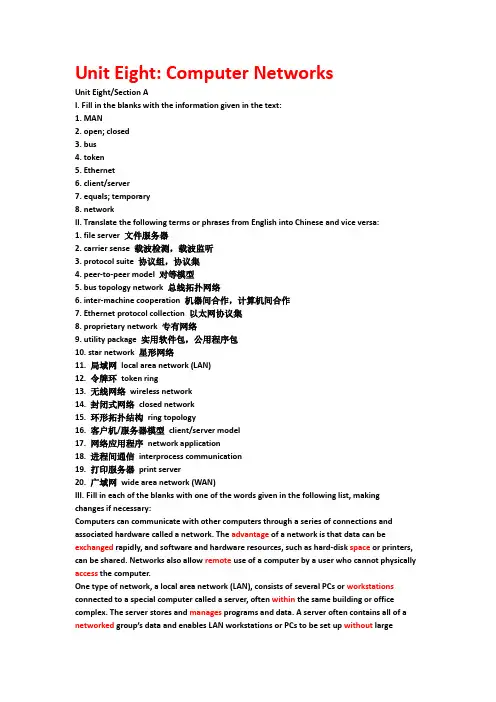
Unit Eight: Computer NetworksUnit Eight/Section AI. Fill in the blanks with the information given in the text:1. MAN2. open; closed3. bus4. token5. Ethernet6. client/server7. equals; temporary8. networkII. Translate the following terms or phrases from English into Chinese and vice versa:1. file server 文件服务器2. carrier sense 载波检测,载波监听3. protocol suite 协议组,协议集4. peer-to-peer model 对等模型5. bus topology network 总线拓扑网络6. inter-machine cooperation 机器间合作,计算机间合作7. Ethernet protocol collection 以太网协议集8. proprietary network 专有网络9. utility package 实用软件包,公用程序包10. star network 星形网络11. 局域网local area network (LAN)12. 令牌环token ring13. 无线网络wireless network14. 封闭式网络closed network15. 环形拓扑结构ring topology16. 客户机/服务器模型client/server model17. 网络应用程序network application18. 进程间通信interprocess communication19. 打印服务器print server20. 广域网wide area network (WAN)III. Fill in each of the blanks with one of the words given in the following list, making changes if necessary:Computers can communicate with other computers through a series of connections and associated hardware called a network. The advantage of a network is that data can be exchanged rapidly, and software and hardware resources, such as hard-disk space or printers, can be shared. Networks also allow remote use of a computer by a user who cannot physically access the computer.One type of network, a local area network (LAN), consists of several PCs or workstations connected to a special computer called a server, often within the same building or office complex. The server stores and manages programs and data. A server often contains all of a networked group’s data and enables LAN workstations or PCs to be set up without largestorage capabilities. In this scenario (方案), each PC may have “local”memory (for example, a hard drive) specific to itself, but the bulk of storage resides on the server. This reduces the cost of the workstation or PC because less expensive computers can be purchased, and it simplifies the maintenance of software because the software resides only on the server rather than on each individual workstation or PC.IV. Translate the following passage from English into Chinese:在计算机科学中,网络是指由通信设备连接在一起的一组计算机及其相关设备。
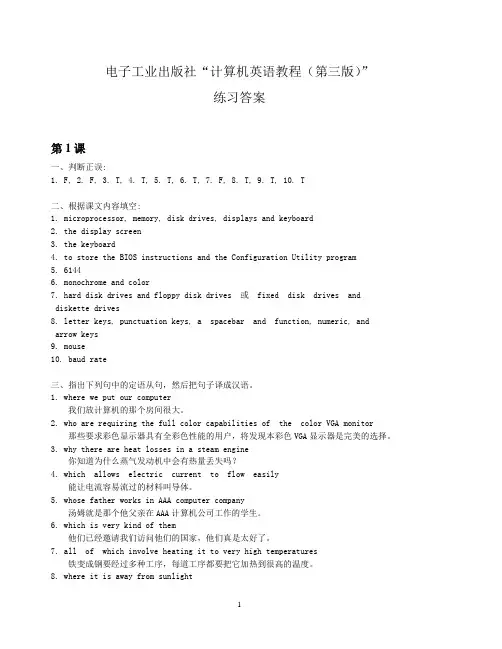
电子工业出版社“计算机英语教程(第三版)”练习答案第1课一、判断正误:1. F,2. F,3. T,4. T,5. T,6. T,7. F,8. T,9. T, 10. T二、根据课文内容填空:1. microprocessor, memory, disk drives, displays and keyboard2. the display screen3. the keyboard4. to store the BIOS instructions and the Configuration Utility program5. 61446. monochrome and color7. hard disk drives and floppy disk drives 或 fixed disk drives anddiskette drives8. letter keys, punctuation keys, a spacebar and function, numeric, andarrow keys9. mouse10. baud rate三、指出下列句中的定语从句,然后把句子译成汉语。
1. where we put our computer我们放计算机的那个房间很大。
2. who are requiring the full color capabilities of the color VGA monitor那些要求彩色显示器具有全彩色性能的用户,将发现本彩色VGA显示器是完美的选择。
3. why there are heat losses in a steam engine你知道为什么蒸气发动机中会有热量丢失吗?4. which allows electric current to flow easily能让电流容易流过的材料叫导体。
5. whose father works in AAA computer company汤姆就是那个他父亲在AAA计算机公司工作的学生。
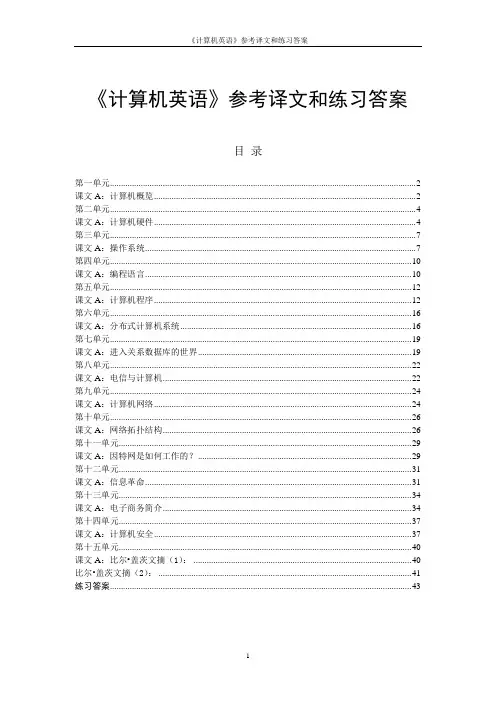
《计算机英语》参考译文和练习答案目录第一单元 (2)课文A:计算机概览 (2)第二单元 (4)课文A:计算机硬件 (4)第三单元 (7)课文A:操作系统 (7)第四单元 (10)课文A:编程语言 (10)第五单元 (12)课文A:计算机程序 (12)第六单元 (16)课文A:分布式计算机系统 (16)第七单元 (19)课文A:进入关系数据库的世界 (19)第八单元 (22)课文A:电信与计算机 (22)第九单元 (24)课文A:计算机网络 (24)第十单元 (26)课文A:网络拓扑结构 (26)第十一单元 (29)课文A:因特网是如何工作的? (29)第十二单元 (31)课文A:信息革命 (31)第十三单元 (34)课文A:电子商务简介 (34)第十四单元 (37)课文A:计算机安全 (37)第十五单元 (40)课文A:比尔•盖茨文摘(1): (40)比尔•盖茨文摘(2): (41)练习答案 (43)第一单元课文A:计算机概览一、引言计算机是一种电子设备,它能接收一套指令或一个程序,然后通过对数值数据进行运算或者对其他形式的信息进行处理来执行该程序。
如果没有计算机的发展,现代的高科技世界是不可能产生的。
在整个社会,不同型号和不同大小的计算机被用于存储和处理各种数据,从政府保密文件、银行交易到私人家庭账目。
计算机通过自动化技术开辟了制造业的新纪元,而且它们也增强了现代通信系统的性能。
在几乎每一个研究和应用技术领域,从构建宇宙模型到产生明天的气象报告,计算机无不是必要的工具,并且它们的应用本身就开辟了人们推测的新领域。
数据库服务和计算机网络使各种各样的信息源可供使用。
同样的先进技术也使侵犯个人隐私和商业秘密成为可能。
计算机犯罪已经成为作为现代技术代价组成部分的许多风险之一。
二、历史第一台加法机,数字计算机的先驱,是1642年由法国科学家、数学家兼哲学家布莱斯•帕斯卡设计的。
这个装置使用了一系列有10个齿的轮子,每个齿代表从0到9的一个数字。
Unit Eight: Computer NetworksUnit Eight/Section AI. Fill in the blanks with the information given in the text:1. MAN2. open; closed3. bus4. token5. Ethernet6. client/server7. equals; temporary8. networkII. Translate the following terms or phrases from English into Chinese and vice versa:1. file server 文件服务器2. carrier sense 载波检测,载波监听3. protocol suite 协议组,协议集4. peer-to-peer model 对等模型5. bus topology network 总线拓扑网络6. inter-machine cooperation 机器间合作,计算机间合作7. Ethernet protocol collection 以太网协议集8. proprietary network 专有网络9. utility package 实用软件包,公用程序包10. star network 星形网络11. 局域网local area network (LAN)12. 令牌环token ring13. 无线网络wireless network14. 封闭式网络closed network15. 环形拓扑结构ring topology16. 客户机/服务器模型client/server model17. 网络应用程序network application18. 进程间通信interprocess communication19. 打印服务器print server20. 广域网wide area network (WAN)III. Fill in each of the blanks with one of the words given in the following list, making changes if necessary:Computers can communicate with other computers through a series of connections and associated hardware called a network. The advantage of a network is that data can be exchanged rapidly, and software and hardware resources, such as hard-disk space or printers, can be shared. Networks also allow remote use of a computer by a user who cannot physically access the computer.One type of network, a local area network (LAN), consists of several PCs or workstations connected to a special computer called a server, often within the same building or office complex. The server stores and manages programs and data. A server often contains all of a networked group’s data and enables LAN workstations or PCs to be set up without largestorage capabilities. In this scenario (方案), each PC may have “local”memory (for example, a hard drive) specific to itself, but the bulk of storage resides on the server. This reduces the cost of the workstation or PC because less expensive computers can be purchased, and it simplifies the maintenance of software because the software resides only on the server rather than on each individual workstation or PC.IV. Translate the following passage from English into Chinese:在计算机科学中,网络是指由通信设备连接在一起的一组计算机及其相关设备。
计算机专业英语教程(第三版)练习答案计算机专业英语教程Array第三版练习参考答案Unit 1 [Ex 1] 1. F 2. T 3. T 4. F 5. T 6. T 7. T 8. T 9. T 10. F [Ex 2] 1. input, storage, processing, and output 2. power; speed; memory3. central processing unit4. internal; primary; memory5. keyboard; central processing unit; main memory; monitor[Ex 3] A. 1. F 2. D 3. G 4. C 5. B 6. A 7. E 8. HB. 1. user 2. monitor 3. data 4. keyboard 5. data processing6. information7. computer8. memory[Ex 4] 1. input device 2. screen, screen 3. manipulates 4. instructions 5. retrieve6. code7. hard copy8. function[Ex 5] 1. T 2. T 3. F 4. F 5. T 6. F 7. T 8. FUnit 2 [Ex 1] 1. T 2. F 3. T 4. F 5. T 6. T 7. T 8. F[Ex 2] 1. sizes, shapes, processing capabilities2. supercomputers, mainframe computers, minicomputers, microcomputers3. mainframe computer4. microcomputers, storage locations5. protables, laptop computers/notebook/palm-sized computer.desktop workstations6. semiconductor7. CPU, memory, storage, devices, processing, users8. microprocessor chip[Ex 3] A. 1. C 2. A 3. H 4. I 5. E 6. F 7. G 8. BB. 1. capacity 2. device 3. laptop computer 4. Portable computers5. Silicon6. semiconductor7. workstation8. voltage9. RAM 10. ROM[Ex 4] 1. portable 2. access 3. main memory 4. sophisiticated programs5. processing capability6. instructions7. computation8. computer professional[Ex 5] 1. T 2. T 3. T 4. F 5. F 6. T 7. F 8. T 9. F 10. T 11. F13. T 14. TUnit 3 [Ex 1] 1. T 2. F 3. T 4. T 5. T 6. T 7. F 8. F 9. T11. T 12. F 13. F 14. T[Ex 2] 1. microprocessor 2. bus 3. register 4. control unit 5. processor6. binary7. arithmetic, logical8. milliseconds,nanoseconds. 9. instruction 10. execution 11. megahertz 12. wordsize [Ex 3] A. 1. F 2. A 3. J 4. C 5. D 6. E 7. H 8. I 9. B 10. GB. 1. Storage 2. chip 3. registers 4. ALU 5. bus 6. control unit7. machine language 8. binary system 9. bits 10. computer program[Ex 4] 1. configuration 2. converts 3. data buses 4. characters3.远远不能覆盖绝⼤多数嫌疑⼈4.真正奇才所掌握的技术5.⽂件和程序6. 1. 系统详情、扩展其性能5. 敏感信息的⼈7.滞缓的特性和控制开发的复杂性8.⾮常巧妙的权宜之计,旨在解决很棘⼿的问题9.不能有效与他⼈沟通的⼈10.⼀个程序、数据结构或全部程序的11.交叉指向不合适的新闻组12.打免费长途电话了;通信⽹络,但不单指通信⽹络13.眼睛疲劳14.⽆关紧要或令⼈讨厌的琐碎问题15.不会有⼈发现这些漏洞的,或发现了也不会利⽤16.受⼈雇佣,为测试系统的安全性⽽攻⼊某个地⽅17.那种使⽤许多GOTO、例外或另外的“⾮结构的”分⽀构造18.不能定期运⾏适当的抑制程序19.某种⾮常友好程序的20.远在没有正式发⾏之前21.该技术也许不能发挥作⽤。
新编计算机英语课后习题答案(第三版)王春生Unit Seven: Computer Communications Unit Seven/Section A I. Fill in the blanks with the information given in the text: 1. telegraph 2. dots; dashes 3. media 4. point-to-point 5. analog 6. digital 7. text-based 8. modem II. Translate the following terms or phrases from English into Chinese and vice versa: 1. microwave radio 微波无线电2. digital television 数字电视3. DSL 数字用户线路4. analog transmission 模拟传输5. on-screen pointer 屏幕上的指针6. computer terminal 计算机终端7. radio telephone 无线电话8. cellular telephone 蜂窝电话,移动电话,手机9. decentralized network 分散型网络10. wire-based internal network 基于导线的内部网络,有线内部网11. 光缆fiber-optic cable12. 传真机fax machine13. 无线通信wireless communications14. 点对点通信point-to-point communications15. 调制电脉冲modulated electrical impulse16. 通信卫星communication(s) satellite17. 电报电键telegraph key18. 传输媒体transmission medium (或media)19. 无绳电话cordless telephone20. 金属导体metal conductorIII. Fill in each of the blanks with one of the words given in the following list, makingchanges if necessary:Data communications is the process of transmitting and receiving data in an orderly wayso the data that arrives at its destination is an accurate duplication (复制) of the data that was sent. When data travels a short distance, such as when you send data from your computer to your printer, it is referred to as local communications. When data travels a long distance, thecommunication is referred to as telecommunications; the prefix (前缀) “tele” is derived from aGreek word that mean s “far” or “far off.”The difference between a short distance and a long distance is somewhat arbitrary (武断的). For example, if your computer sends data to a printer in the next room, it is regarded as local communications; if you phone the person in the next room, you are transmitting data over a telecommunications device. However, the same basic communications concepts apply to both local communications and telecommunications.Basic data communications concepts are the building blocks for understanding how datatravels on a communications system. These concepts come in handy (派得上用处) when you install, configure, or upgrade a local area network. In addition, these concepts help you set up modems, fax machines, and cellular data transfers.IV. Translate the following passage from English into Chinese: 个人计算机使用电信来提供传输链路,用于传送音频、视频、文本、软件和多媒体服务。
电子工业出版社“计算机英语教程(第三版)”练习答案第1课一、判断正误:1. F,2. F,3. T,4. T,5. T,6. T,7. F,8. T,9. T, 10. T二、根据课文内容填空:1. microprocessor, memory, disk drives, displays and keyboard2. the display screen3. the keyboard4. to store the BIOS instructions and the Configuration Utility program5. 61446. monochrome and color7. hard disk drives and floppy disk drives 或 fixed disk drives anddiskette drives8. letter keys, punctuation keys, a spacebar and function, numeric, andarrow keys9. mouse10. baud rate三、指出下列句中的定语从句,然后把句子译成汉语。
1. where we put our computer我们放计算机的那个房间很大。
2. who are requiring the full color capabilities of the color VGA monitor那些要求彩色显示器具有全彩色性能的用户,将发现本彩色VGA显示器是完美的选择。
3. why there are heat losses in a steam engine你知道为什么蒸气发动机中会有热量丢失吗?4. which allows electric current to flow easily能让电流容易流过的材料叫导体。
5. whose father works in AAA computer company汤姆就是那个他父亲在AAA计算机公司工作的学生。
Unit 8 Shopping / Operating a Computer课后习题答案(Keys to Task 4)1.Oral practice.First, make a list of things that you are going to buy this year, then talk about your shopping plan with your partner.Omitted.2.Fill in the blanks with proper forms of words and phrases given.(1)avoiding(2)comparison, discount coupon(3)privacy(4)protect3.Write T for true and F for false to each statement.(1)T(2)T(3)T(4) F(5) F习题册答案(Keys to the exercise book)Part One: Vocabulary 词汇用所给的词或短语的正确形式填空。
Part A1.avoid2.protect3.disadvantage4.having a party5.forgetPart B1.submenus2.appears3.arrow4.switch5.As long asPart Two: Grammar & Function 语法与功能1.在右列中找出可与左列对应的句子。
(1) D(2) A(3) E(4) C(5) B2.从A、B、C、D选项中选择正确答案。
(1) C(2) D(3) B(4) D(5) B(6) C(7) B(8) A(9) A(10) BPart Three: Translation 翻译1.将下列短语翻译成英文。
(1)avoiding crowds(2)discount coupons(3)privacy and security concerns(4)in order to use a computer(5)taskbar(6)the bottom of a window2.将下列句子翻译成中文。
Unit Five: Software ProcessUnit Five/Section AI. Fill in the blanks with the information given in the text:1. off-the-shelf1 2. exclusive2 3. cascade3 4. requirements; integration4 5. throwaway5 6. immediate; stable67. reuse-oriented; framework78. software; compromisesII. Translate the following terms or phrases from English into Chinese and vice versa:1 1. system specification 系统规格说明2 2. unit testing 单位(或单元、部件)测试3 3. software life cycle 软件生命周期(或生存周期)4 4. system validation testing 系统验证测试5 5. evolutionary development process 演化开发过程6 6. simple linear model 简单线性模型77. program unit 程序单元88. throwaway prototype 抛弃式原型99. text formatting 正文格式编排,文本格式化1010. system evolution 系统演变1111. 系统设计范例system design paradigm1212. 需求分析与定义requirements analysis and definition1313. 探索式编程方法exploratory programming approach1414. 系统文件编制system documentation1515. 瀑布模型waterfall model1616. 系统集成system integration1717. 商用现成软件commercial off-the-shelf ( 或COTS) software1818. 基于组件的软件工程component-based software engineering (CBSE)1919. 软件维护工具software maintenance tool2020. 软件复用software reuseIII. Fill in each of the blanks with one of the words given in the following list, makingchanges if necessary:There are three different types of software maintenance. Firstly, there is maintenance to repair software faults. Coding errors are usually relatively cheap to correct; design errors are more expensive as they may involve rewriting several program components. Requirements errors are the most expensive to repair because of the extensive system redesign that may be necessary. Secondly,there is maintenance to adapt the software to a different operating environment. This type of maintenance is required when some aspect of the system’s environment such as the hardware, the platform operating system or other support software changes. The application system must be modified to adapt it to cope with these environmental changes. And thirdly, there is maintenance to add to or modify the system’s functionality. This type of maintenance is necessary when the system requirements change in response to organizational or business change. The scale of the changes required to the software is often much greater than for the other types of maintenance. In practice, there isn’t a clear-cut distinction between these types of maintenance. When you adapt the system toa new environment, you may add functionality to take advantage of new environmental features.Software faults are often exposed because users use the system in unanticipated ways. Changing the system to accommodate their way of working is the best way to fix these faults.IV. Translate the following passage from English into Chinese:软件过程比较复杂,而且像所有其他的智能和创造性过程一样,依靠人们作出决定和判断。
《计算机英语(第3版)》练习参考答案Unit One: Computer and Computer ScienceUnit One/Section AI.Fill in the blanks with the information given in the text:1. Charles Babbage; Augusta Ada Byron2. input; output3. VLSI4. workstations; mainframes5. vacuum; transistors6. instructions; software7. digit; eight; byte8. microminiaturization; chip计算机英语(第3版)II.Translate the following terms or phrases from English into Chinese and vice versa:1. artificial intelligence 人工智能2. paper-tape reader 纸带阅读器3. optical computer 光计算机4. neural network 神经网络5. instruction set 指令集6. parallel processing 并行处理7. difference engine 差分机8. versatile logical element 通用逻辑元件9. silicon substrate 硅衬底10. vacuum tube 真空管11. 数据的存储与处理the storage and handling of data12. 超大规模集成电路very large-scale integrated circuit13. 中央处理器central processing unit14. 个人计算机personal computer15. 模拟计算机analogue computer16. 数字计算机digital computer17. 通用计算机general-purpose computer18. 处理器芯片processor chip19. 操作指令operating instructions20. 输入设备input deviceIII.Fill in each of the blanks with one of the words given in the following list, making changes if necessary:We can define a computer as a device that accepts input, processes data, stores data, and produces output. According to the mode of processing, computers are either analog or digital.They can also be classified as mainframes, minicomputers, workstations, or microcomputers.All else (for example, the age of the machine) being equal, this categorization provides some indication of the computer’s speed, size, cost, and abilities.Ever since the advent of computers, there have been constant changes. First-generation 计算机英语(第3版) computers of historic significance, such as UNIVAC(通用自动计算机), introduced in theearly 1950s, were based on vacuum tubes. Second-generation computers, appearing in the early 1960s, were those in which transistors replaced vacuum tubes. In third-generation computers, dating from the 1960s, integrated circuits replaced transistors. In fourth-generation computers such as microcomputers, which first appeared in the mid-1970s, large-scale integration enabled thousands of circuits to be incorporated on one chip. Fifth-generation computers are expected to combine very-large-scale integration with sophisticated approaches to computing, including artificial intelligence and true distributed processing.IV. Translate the following passage from English into Chinese:计算机将变得更加先进,也将变得更加容易使用。
语音识别的改进将使计算机的操作更加容易。
虚拟现实,即使用所有人类官能与计算机进行交互的技术,也将有助于创建更好的人机接口。
人们正在开发其他的奇异计算模型,包括使用生物机体的生物计算、使用具有特定属性的分子的分子计算,以及使用遗传基本单位DNA(脱氧核糖核酸)存储数据和执行操作的计算。
这些都是可能的未来计算平台的例子,而它们迄今还能力有限或完全属于理论范畴。
科学家们研究它们,是因为嵌入硅中的电路的微小型化受到物理限制。
还有一些限制与甚至最微小的晶体管也会产生的热量有关。
Unit One/Section BI.Fill in the blanks with the information given in the text:1. experimentation2. interfacing3. interdisciplinary4. microprocessorII.Translate the following terms or phrases from English into Chinese and vice versa:1. artificial neural network 人工神经网络2. computer architecture 计算机体系结构3. robust computer program 健壮的计算机程序4. human-computer interface 人机接口5. knowledge representation 知识表示计算机英语(第3版)6. 数值分析numerical analysis7. 程序设计环境programming environment8. 数据结构data structure9. 存储和检索信息store and retrieve information10. 虚拟现实virtual realityUnit One/Section CI.Fill in the blanks with the information given in the text:1. format2. synchronization3. virtual4. multimedia; third-partyII.Translate the following terms or phrases from English into Chinese and vice versa:1. data field 数据字段,数据域2. learning curve 学习曲线3. third-party solution 第三方解决方案4. Windows Media Player Windows媒体播放器5. 开始按钮Start button6. 指定输入区designated input area7. 手写体识别系统handwriting-recognition system8. 字符集character setUnit Two: Computer ArchitectureUnit Two/Section AI.Fill in the blanks with the information given in the text:1. input; output; storage2. Basic Input/Output System3. flatbed scanners; hand-held scanners计算机英语(第3版)4. LCD-based5. dot-matrix printers; inkjet printers6. disk drives; memory7. volatile8. serial; parallelII.Translate the following terms or phrases from English into Chinese and vice versa:1. function key 功能键,操作键2. voice recognition module 语音识别模块3. touch-sensitive region 触敏区4. address bus 地址总线5. flatbed scanner 平板扫描仪6. dot-matrix printer 点阵打印机(针式打印机)7. parallel connection 并行连接8. cathode ray tube 阴极射线管9. video game 电子游戏10. audio signal 音频信号11. 操作系统operating system12. 液晶显示(器)LCD (liquid crystal display)13. 喷墨打印机inkjet printer14. 数据总线data bus15. 串行连接serial connection16. 易失性存储器volatile memory17. 激光打印机laser printer18. 磁盘驱动器disk drive19. 基本输入/输出系统BIOS (Basic Input/Output System)20. 视频显示器video displayIII.Fill in each of the blanks with one of the words given in the following list, making changes if necessary:CD-ROM stands for compact disc read-only memory. Unlike floppy and hard disks,计算机英语(第3版)which use magnetic charges to represent 1s and 0s, optical discs use reflected light. On a CD-ROM disc, 1s and 0s are represented by flat areas and bumpy (高低不平的) areas (called “pits”) on its bottom surface. The CD-ROM disc is read by a laser that projects a tiny beam of light on these areas. The amount of reflected light determines whether the area represents a 1 or a 0.Like a commercial CD found in music stores, a CD-ROM is a “read-only” disc.Read-only means it cannot be written on or erased by the user. Thus, you as a user have access only to the data imprinted (压印) by the publisher.A single CD-ROM disc can store 650 megabyte s (兆字节) of data. That is equivalent to451 floppy disks. With that much information on a single disc, the time to retrieve or access the information is very important. An important characteristic of CD-ROM drives is their access rate.IV. Translate the following passage from English into Chinese:调制解调器是在模拟和数字信号之间进行转换的设备。